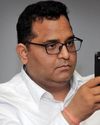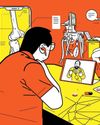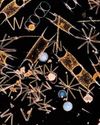Hidden within Abu Dhabi’s glitz are historical gems that hark back to a desert life that has long been forgotten.

Under an overcast sky, and in the late evening light, the newly renovated and illuminated Qasr Al Hosn complex, in the glass-and-steel heart of Abu Dhabi,looked resplendent as we made our way into it. Inside, at the visitor centre, hung a black-and-white photograph from the 1970s, showing what the complex looked like then: A small fort with a watchtower, as tall as a three-storey building, standing in the midst of nothing but miles of barren land.
The oldest structure in the Abu Dhabi island, Qasr Al Hosn, has witnessed the evolution of the city, including the union of the many tribes that roamed the lands, and the very formation of the United Arab Emirates.
Legend has it that in 1761, Bedouin hunters followed a deer from Liwa, an oasis in the south of Abu Dhabi, to the coast in the north, and discovered shallow water beds under the sand. Word spread fast, and soon the area transformed into a small fishing village, the genesis of Abu Dhabi.
Stories aside, Bedouins were nomads who moved with the seasons. For centuries, people of the Bani Yas tribe left their ancestral home at Liwa, a collection of oases at the fringe of the Rub Al Khali desert or the ‘Empty Quarter’, looking for fresh water and pastures for their animals, and to trade their dates. Documents suggest that the tribe possibly also visited the Abu Dhabi island periodically to fish, dive for pearls, and collect salt.
هذه القصة مأخوذة من طبعة May 24, 2019 من Forbes India.
ابدأ النسخة التجريبية المجانية من Magzter GOLD لمدة 7 أيام للوصول إلى آلاف القصص المتميزة المنسقة وأكثر من 9,000 مجلة وصحيفة.
بالفعل مشترك ? تسجيل الدخول
هذه القصة مأخوذة من طبعة May 24, 2019 من Forbes India.
ابدأ النسخة التجريبية المجانية من Magzter GOLD لمدة 7 أيام للوصول إلى آلاف القصص المتميزة المنسقة وأكثر من 9,000 مجلة وصحيفة.
بالفعل مشترك? تسجيل الدخول

Home-Cooked Meal Is Now Greatly Valued
The pandemic has also brought with it an improved focus on hygiene, use of technology in dining, rise of cloud kitchens and resurgence in popularity of Indian ingredients

Paytm 3.0 - Reaching Near Breakeven In Two Years
As of 2020, Vijay Shekhar Sharma’s super app for financial services had run up losses in thousands of crores. Now, as digital payments gets yet another boost courtesy Covid-19, he’s hopeful of reaching near breakeven in two years

THE PANDEMIC HAS CAUSED WOMEN GREATER LABOUR PAIN
Covid-19 has shown that women are more likely to face the brunt of job losses than men, and find fewer opportunities when they want to resume. That apart, several have to deal with increased hours of unpaid work at home and even domestic abuse

LEADERSHIP WILL BE ABOUT SEEING THE BIGGER PICTURE
Leaders must not only guard their teams first during a crisis, but also deal with stakeholders with respect and dignity. And apart from pursuing business goals, they should remain committed to our planet and the environment

PHILANTHROPY SHOULD BE HUMBLE, BUT NOT MODEST
Apart from building a flexible and resilient framework for the future, philanthropists, civil society and the government must work in tandem so that every rupee is absorbed on the ground

INTEGRATED HEALTH CARE, TECH WILL DISRUPT SECTOR
While clinical research will get a boost, having a skilled workforce and public spending on health care will be challenges in the near term

DIGITALISATION WILL HELP IN VALUE CREATION
As the pandemic brings technology and innovation to the core of business and daily life, the next decade will see about 150 million digital-first families in India

Industry 4.0: Climate Revolution?
Augmenting sustainability alongside digital capabilities is an economic, competitive and global opportunity for India’s businesses, but regulations need to reflect intent

EV Dream Still Miles Away
Electric vehicles have remained a buzzword in India for years. But not much has moved on ground due to high upfront costs, range anxiety and charging infrastructure

Living Waters
A virus has caused us to scramble for oxygen but our chokehold on the environment is slowly strangling the very waters that breathe life into us. The virus is a timely reminder: We are merely consumers, not producers of life’s breath on this planet